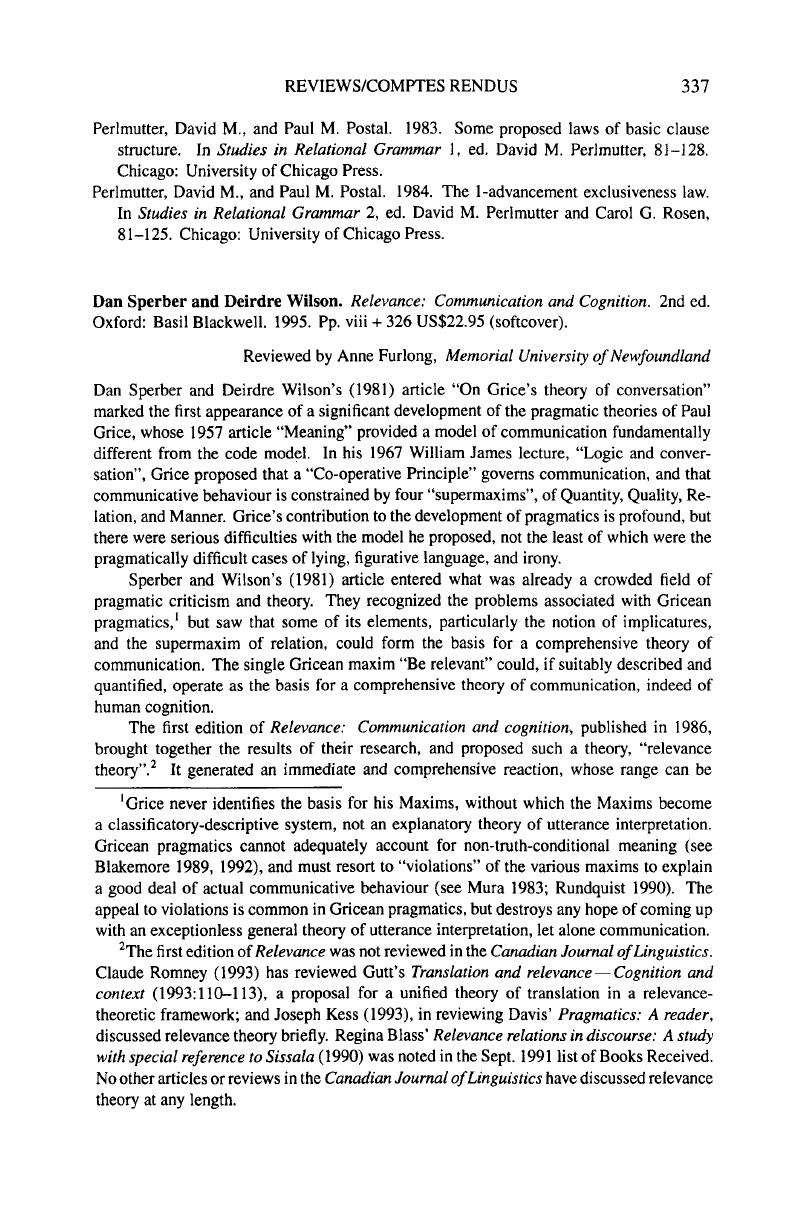No CrossRef data available.
Article contents
Dan Sperber and Deirdre Wilson. Relevance: Communication and Cognition. 2nd ed. Oxford: Basil Blackwell. 1995. Pp. viii + 326 US$22.95 (softcover).
Published online by Cambridge University Press: 27 June 2016
Abstract
An abstract is not available for this content so a preview has been provided. Please use the Get access link above for information on how to access this content.

- Type
- Reviews/Comptes rendus
- Information
- Canadian Journal of Linguistics/Revue canadienne de linguistique , Volume 42 , Issue 3 , September 1997 , pp. 337 - 342
- Copyright
- Copyright © Canadian Linguistic Association 1997
References
Blakemore, Diane. 1989. Denial and contrast: A relevance theoretic analysis of but. Linguistics and Philosophy
12:15–38.Google Scholar
Blakemore, Diane. 1992. Understanding utterances: An introduction to pragmatics. Oxford: Basil Blackwell.Google Scholar
Blass, Regina. 1990. Relevance relations in discourse: A study with special reference to Sissala. Oxford: Basil Blackwell.Google Scholar
Cooley, Ralph. 1983. Codes and contexts: An argument for their description. In Intercultural Communication Theory: Current perspectives, ed. Gudykunst, William, 241–251. Beverly Hills: Sage.Google Scholar
Eco, Umberto. 1983. Horns, hooves, insteps: Some hypotheses on three types of abduction. In The sign of three: Dupin, Holmes, Peirce, ed. Eco, Umberto and Sebeok, Thomas, 198–220. Bloomington: Indiana University Press.Google Scholar
Gutt, Ernst-August. 1991. Translation and relevance — Communication and context. Oxford: Basil Blackwell.Google Scholar
Harris, Roy. 1982. The speech communication model in 20th-century linguistics and its sources. In Proceedings of the XIIIth International Congress of Linguistics, August 29-September 4, 1982, Tokyo, ed. Hattori, Shiro, Inoue, Kazuko, Simomiya, Tadao, and Nagashima, Yoshio, 864–869. Tokyo: Tokyo Press.Google Scholar
Kess, Joseph. 1993. Review of Steven Davis, Pragmatics: A reader. Canadian Journal of Linguistics
38:454–456.Google Scholar
Mura, Susan. 1983. Licensing violations: Legitimate violations of Grice’s conversational principle. In Conversational coherence: Form, structure, and strategy, ed. Graig, Robert and Tracey, Karen, 101–115. Beverly Hills: Sage.Google Scholar
Récanati, François. 1989. The pragmatics of what is said. Mind and Language
4:295–329.Google Scholar
Romney, Claude. 1993. Review of Ernst-August Gutt, Translation and relevance — Communication and context. Canadian Journal of Linguistics
38:110–113.Google Scholar
Rundquist, Suellen. 1990. Indirectness in conversation: Flouting Grice’s maxims at dinner. In Proceedings of the Sixteenth Annual Meeting of the Berkeley Linguistics Society, February 16-19, 1990: General Session and Parasession on the Legacy of Grice, ed. Hall, Kira, Koenig, Jean-Pierre, Meachem, Michael, Reinman, Sondra, and Sutton, Laurel, 509–518. Berkeley: Berkeley Linguistics Society.Google Scholar
Sperber, Dan, and Wilson, Deirdre. 1981. On Grice’s theory of conversation. In Conversation and Discourse, ed. Werth, Paul, 155–178. London: Croom Helm.Google Scholar
Sperber, Dan, and Wilson, Deirdre. 1987. Précis of Relevance (plus open peer commentary and authors’ response). The Behavioral and Brain Sciences
10:697–754.Google Scholar




